Taxation Law: Analysis of Sarah's Income and Deductions - UTS 2019
VerifiedAdded on 2023/04/26
|11
|2359
|493
Report
AI Summary
This report provides a comprehensive analysis of Sarah's income tax obligations based on the provided facts. It examines various aspects of her income, including her salary from DesignCo Ltd and her teaching position, and determines whether these incomes are taxable under Section 6-5 of the ITAA 1997. The report also assesses her eligibility for income tax deductions, considering expenses related to her home office, design equipment, membership fees, travel, clothing, and self-education. Each expense is evaluated based on relevant sections of the ITAA 1997 and case law to determine deductibility. Furthermore, the report addresses the capital gains tax (CGT) implications of selling antique furniture. A detailed computation of Sarah's taxable income and net tax payable is included, along with a depreciation worksheet for the design equipment. The report concludes by summarizing the key findings regarding the taxability of Sarah's income and the deductibility of her expenses, referencing relevant legal authorities and emphasizing the importance of satisfying the nexus test for deductions.
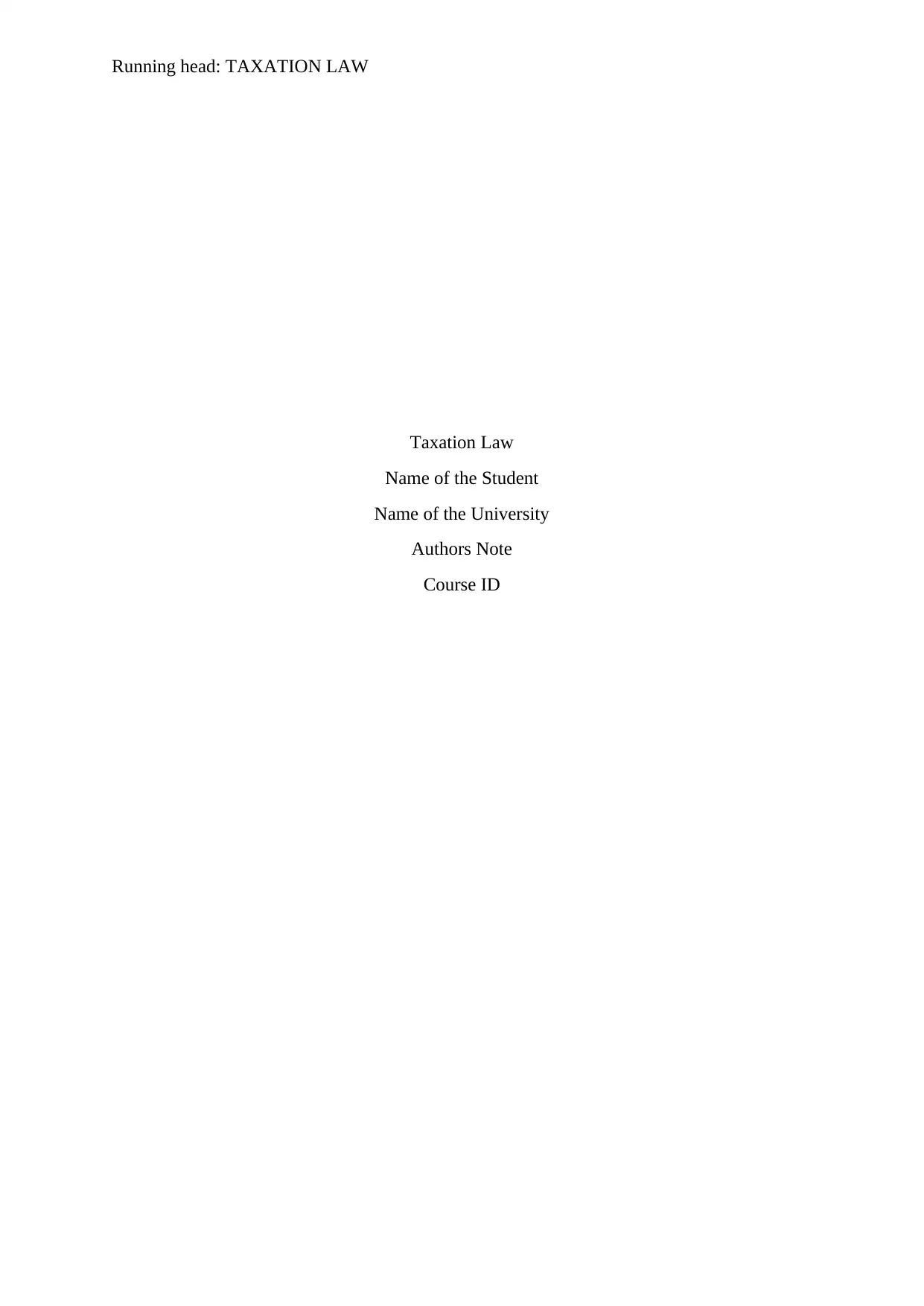
Running head: TAXATION LAW
Taxation Law
Name of the Student
Name of the University
Authors Note
Course ID
Taxation Law
Name of the Student
Name of the University
Authors Note
Course ID
Paraphrase This Document
Need a fresh take? Get an instant paraphrase of this document with our AI Paraphraser
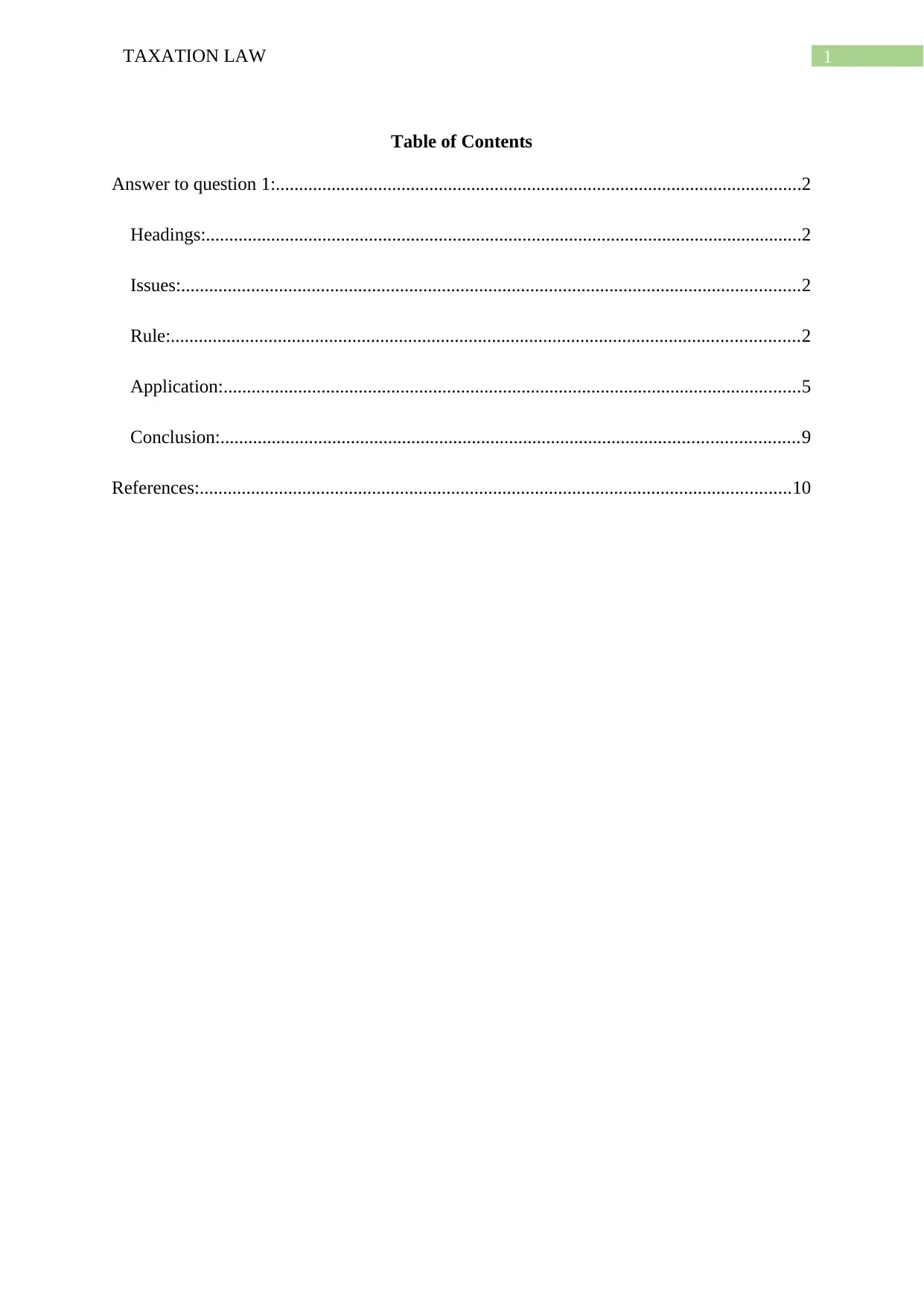
1TAXATION LAW
Table of Contents
Answer to question 1:.................................................................................................................2
Headings:................................................................................................................................2
Issues:.....................................................................................................................................2
Rule:.......................................................................................................................................2
Application:............................................................................................................................5
Conclusion:............................................................................................................................9
References:...............................................................................................................................10
Table of Contents
Answer to question 1:.................................................................................................................2
Headings:................................................................................................................................2
Issues:.....................................................................................................................................2
Rule:.......................................................................................................................................2
Application:............................................................................................................................5
Conclusion:............................................................................................................................9
References:...............................................................................................................................10
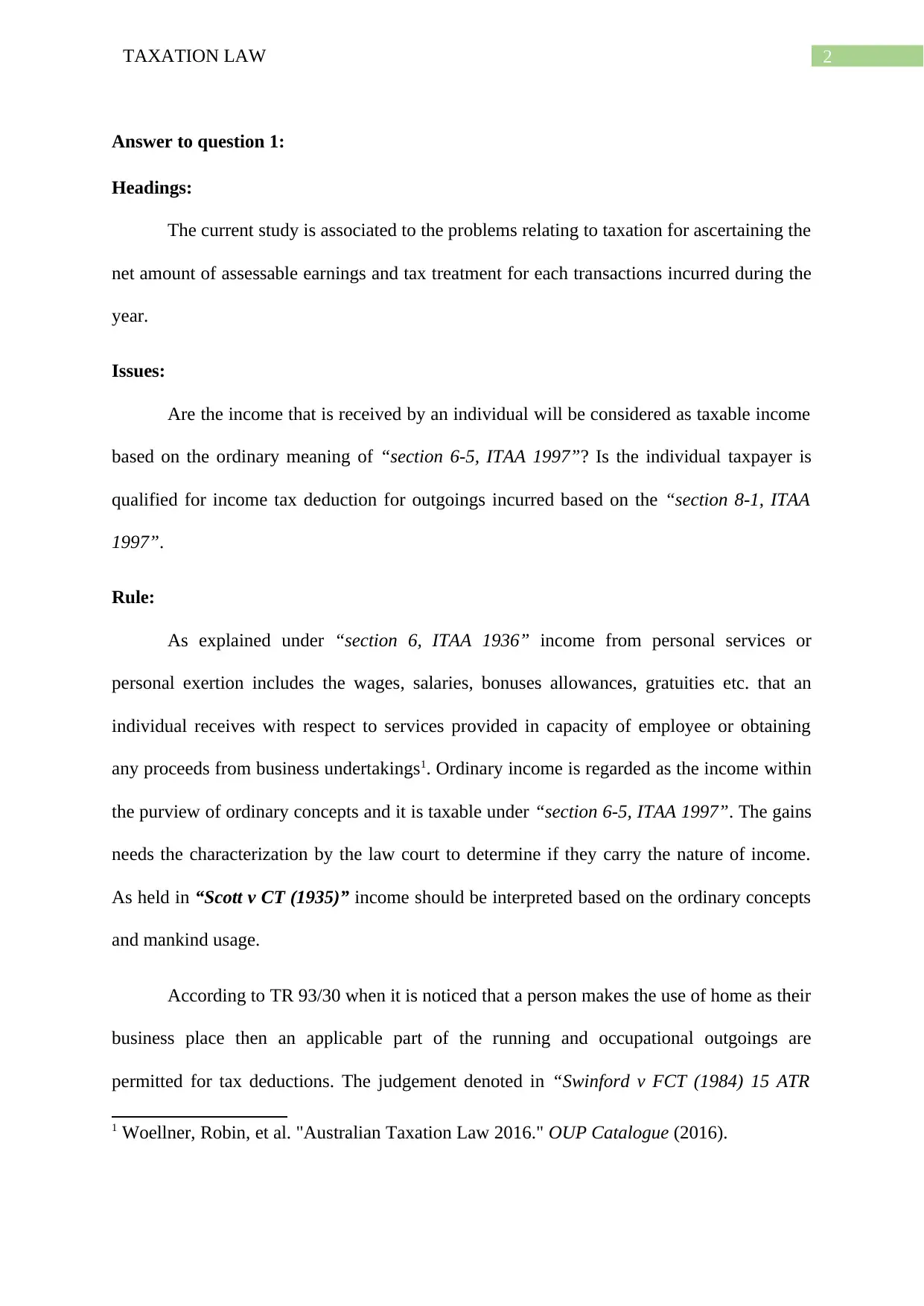
2TAXATION LAW
Answer to question 1:
Headings:
The current study is associated to the problems relating to taxation for ascertaining the
net amount of assessable earnings and tax treatment for each transactions incurred during the
year.
Issues:
Are the income that is received by an individual will be considered as taxable income
based on the ordinary meaning of “section 6-5, ITAA 1997”? Is the individual taxpayer is
qualified for income tax deduction for outgoings incurred based on the “section 8-1, ITAA
1997”.
Rule:
As explained under “section 6, ITAA 1936” income from personal services or
personal exertion includes the wages, salaries, bonuses allowances, gratuities etc. that an
individual receives with respect to services provided in capacity of employee or obtaining
any proceeds from business undertakings1. Ordinary income is regarded as the income within
the purview of ordinary concepts and it is taxable under “section 6-5, ITAA 1997”. The gains
needs the characterization by the law court to determine if they carry the nature of income.
As held in “Scott v CT (1935)” income should be interpreted based on the ordinary concepts
and mankind usage.
According to TR 93/30 when it is noticed that a person makes the use of home as their
business place then an applicable part of the running and occupational outgoings are
permitted for tax deductions. The judgement denoted in “Swinford v FCT (1984) 15 ATR
1 Woellner, Robin, et al. "Australian Taxation Law 2016." OUP Catalogue (2016).
Answer to question 1:
Headings:
The current study is associated to the problems relating to taxation for ascertaining the
net amount of assessable earnings and tax treatment for each transactions incurred during the
year.
Issues:
Are the income that is received by an individual will be considered as taxable income
based on the ordinary meaning of “section 6-5, ITAA 1997”? Is the individual taxpayer is
qualified for income tax deduction for outgoings incurred based on the “section 8-1, ITAA
1997”.
Rule:
As explained under “section 6, ITAA 1936” income from personal services or
personal exertion includes the wages, salaries, bonuses allowances, gratuities etc. that an
individual receives with respect to services provided in capacity of employee or obtaining
any proceeds from business undertakings1. Ordinary income is regarded as the income within
the purview of ordinary concepts and it is taxable under “section 6-5, ITAA 1997”. The gains
needs the characterization by the law court to determine if they carry the nature of income.
As held in “Scott v CT (1935)” income should be interpreted based on the ordinary concepts
and mankind usage.
According to TR 93/30 when it is noticed that a person makes the use of home as their
business place then an applicable part of the running and occupational outgoings are
permitted for tax deductions. The judgement denoted in “Swinford v FCT (1984) 15 ATR
1 Woellner, Robin, et al. "Australian Taxation Law 2016." OUP Catalogue (2016).
⊘ This is a preview!⊘
Do you want full access?
Subscribe today to unlock all pages.

Trusted by 1+ million students worldwide
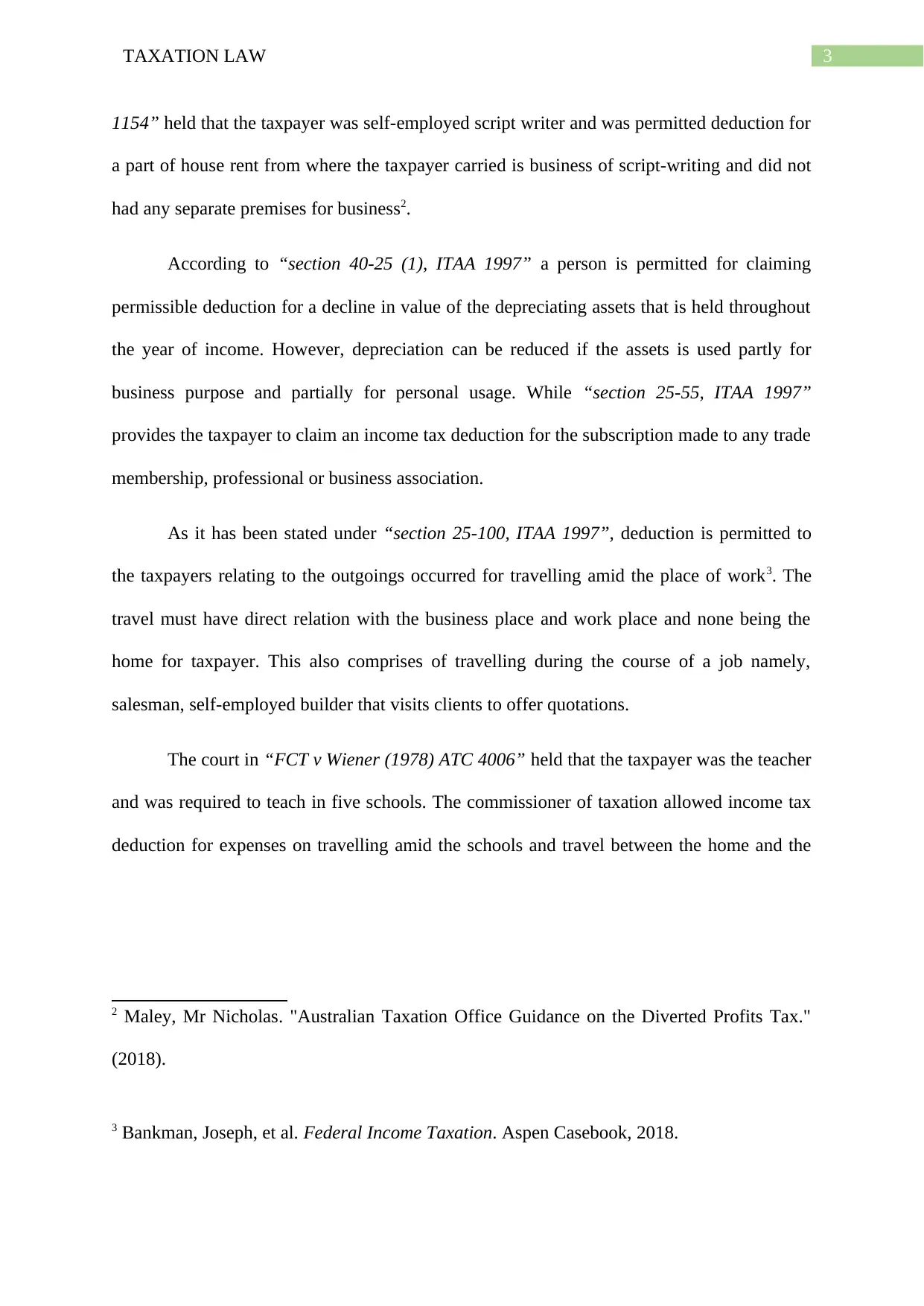
3TAXATION LAW
1154” held that the taxpayer was self-employed script writer and was permitted deduction for
a part of house rent from where the taxpayer carried is business of script-writing and did not
had any separate premises for business2.
According to “section 40-25 (1), ITAA 1997” a person is permitted for claiming
permissible deduction for a decline in value of the depreciating assets that is held throughout
the year of income. However, depreciation can be reduced if the assets is used partly for
business purpose and partially for personal usage. While “section 25-55, ITAA 1997”
provides the taxpayer to claim an income tax deduction for the subscription made to any trade
membership, professional or business association.
As it has been stated under “section 25-100, ITAA 1997”, deduction is permitted to
the taxpayers relating to the outgoings occurred for travelling amid the place of work3. The
travel must have direct relation with the business place and work place and none being the
home for taxpayer. This also comprises of travelling during the course of a job namely,
salesman, self-employed builder that visits clients to offer quotations.
The court in “FCT v Wiener (1978) ATC 4006” held that the taxpayer was the teacher
and was required to teach in five schools. The commissioner of taxation allowed income tax
deduction for expenses on travelling amid the schools and travel between the home and the
2 Maley, Mr Nicholas. "Australian Taxation Office Guidance on the Diverted Profits Tax."
(2018).
3 Bankman, Joseph, et al. Federal Income Taxation. Aspen Casebook, 2018.
1154” held that the taxpayer was self-employed script writer and was permitted deduction for
a part of house rent from where the taxpayer carried is business of script-writing and did not
had any separate premises for business2.
According to “section 40-25 (1), ITAA 1997” a person is permitted for claiming
permissible deduction for a decline in value of the depreciating assets that is held throughout
the year of income. However, depreciation can be reduced if the assets is used partly for
business purpose and partially for personal usage. While “section 25-55, ITAA 1997”
provides the taxpayer to claim an income tax deduction for the subscription made to any trade
membership, professional or business association.
As it has been stated under “section 25-100, ITAA 1997”, deduction is permitted to
the taxpayers relating to the outgoings occurred for travelling amid the place of work3. The
travel must have direct relation with the business place and work place and none being the
home for taxpayer. This also comprises of travelling during the course of a job namely,
salesman, self-employed builder that visits clients to offer quotations.
The court in “FCT v Wiener (1978) ATC 4006” held that the taxpayer was the teacher
and was required to teach in five schools. The commissioner of taxation allowed income tax
deduction for expenses on travelling amid the schools and travel between the home and the
2 Maley, Mr Nicholas. "Australian Taxation Office Guidance on the Diverted Profits Tax."
(2018).
3 Bankman, Joseph, et al. Federal Income Taxation. Aspen Casebook, 2018.
Paraphrase This Document
Need a fresh take? Get an instant paraphrase of this document with our AI Paraphraser
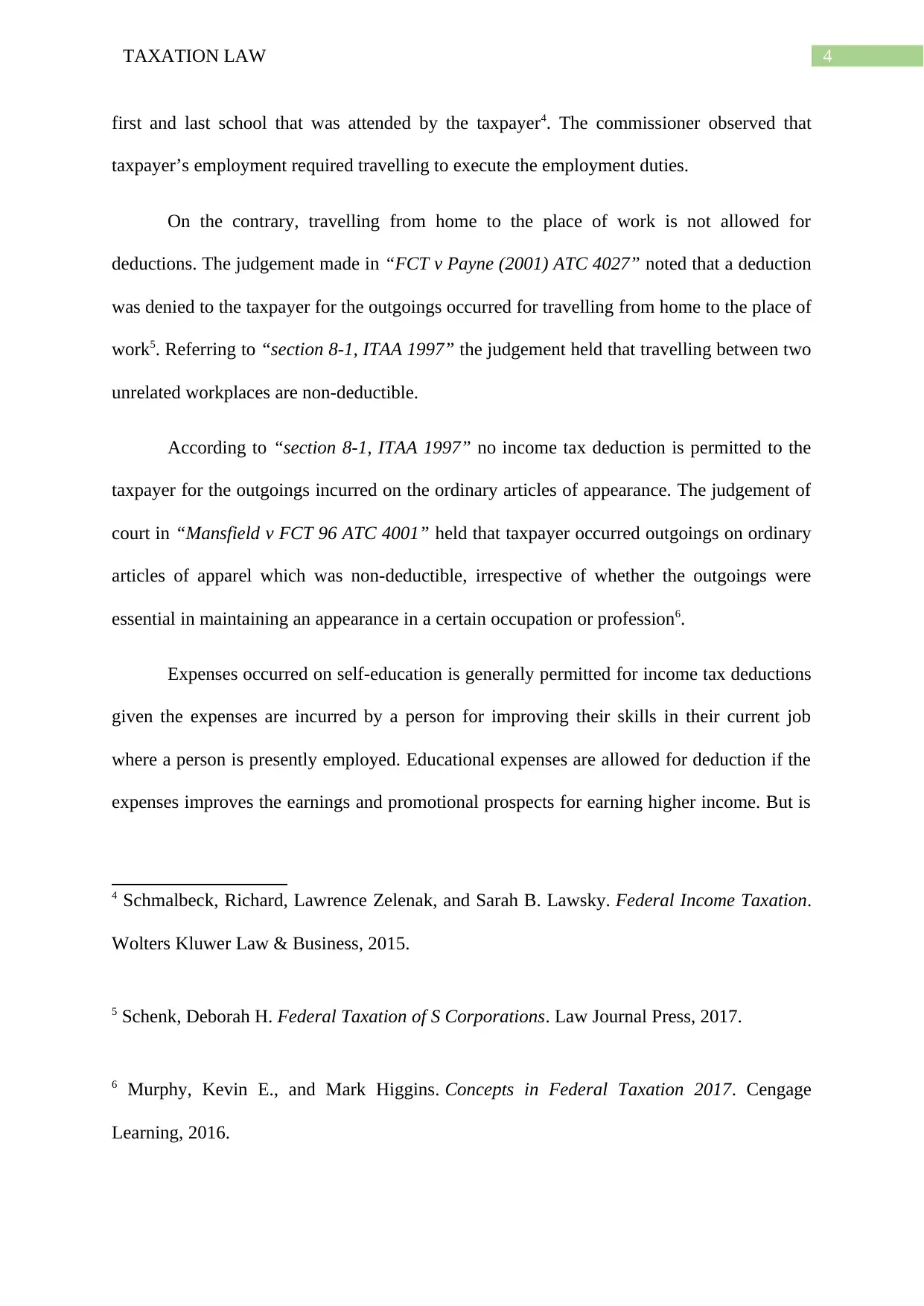
4TAXATION LAW
first and last school that was attended by the taxpayer4. The commissioner observed that
taxpayer’s employment required travelling to execute the employment duties.
On the contrary, travelling from home to the place of work is not allowed for
deductions. The judgement made in “FCT v Payne (2001) ATC 4027” noted that a deduction
was denied to the taxpayer for the outgoings occurred for travelling from home to the place of
work5. Referring to “section 8-1, ITAA 1997” the judgement held that travelling between two
unrelated workplaces are non-deductible.
According to “section 8-1, ITAA 1997” no income tax deduction is permitted to the
taxpayer for the outgoings incurred on the ordinary articles of appearance. The judgement of
court in “Mansfield v FCT 96 ATC 4001” held that taxpayer occurred outgoings on ordinary
articles of apparel which was non-deductible, irrespective of whether the outgoings were
essential in maintaining an appearance in a certain occupation or profession6.
Expenses occurred on self-education is generally permitted for income tax deductions
given the expenses are incurred by a person for improving their skills in their current job
where a person is presently employed. Educational expenses are allowed for deduction if the
expenses improves the earnings and promotional prospects for earning higher income. But is
4 Schmalbeck, Richard, Lawrence Zelenak, and Sarah B. Lawsky. Federal Income Taxation.
Wolters Kluwer Law & Business, 2015.
5 Schenk, Deborah H. Federal Taxation of S Corporations. Law Journal Press, 2017.
6 Murphy, Kevin E., and Mark Higgins. Concepts in Federal Taxation 2017. Cengage
Learning, 2016.
first and last school that was attended by the taxpayer4. The commissioner observed that
taxpayer’s employment required travelling to execute the employment duties.
On the contrary, travelling from home to the place of work is not allowed for
deductions. The judgement made in “FCT v Payne (2001) ATC 4027” noted that a deduction
was denied to the taxpayer for the outgoings occurred for travelling from home to the place of
work5. Referring to “section 8-1, ITAA 1997” the judgement held that travelling between two
unrelated workplaces are non-deductible.
According to “section 8-1, ITAA 1997” no income tax deduction is permitted to the
taxpayer for the outgoings incurred on the ordinary articles of appearance. The judgement of
court in “Mansfield v FCT 96 ATC 4001” held that taxpayer occurred outgoings on ordinary
articles of apparel which was non-deductible, irrespective of whether the outgoings were
essential in maintaining an appearance in a certain occupation or profession6.
Expenses occurred on self-education is generally permitted for income tax deductions
given the expenses are incurred by a person for improving their skills in their current job
where a person is presently employed. Educational expenses are allowed for deduction if the
expenses improves the earnings and promotional prospects for earning higher income. But is
4 Schmalbeck, Richard, Lawrence Zelenak, and Sarah B. Lawsky. Federal Income Taxation.
Wolters Kluwer Law & Business, 2015.
5 Schenk, Deborah H. Federal Taxation of S Corporations. Law Journal Press, 2017.
6 Murphy, Kevin E., and Mark Higgins. Concepts in Federal Taxation 2017. Cengage
Learning, 2016.
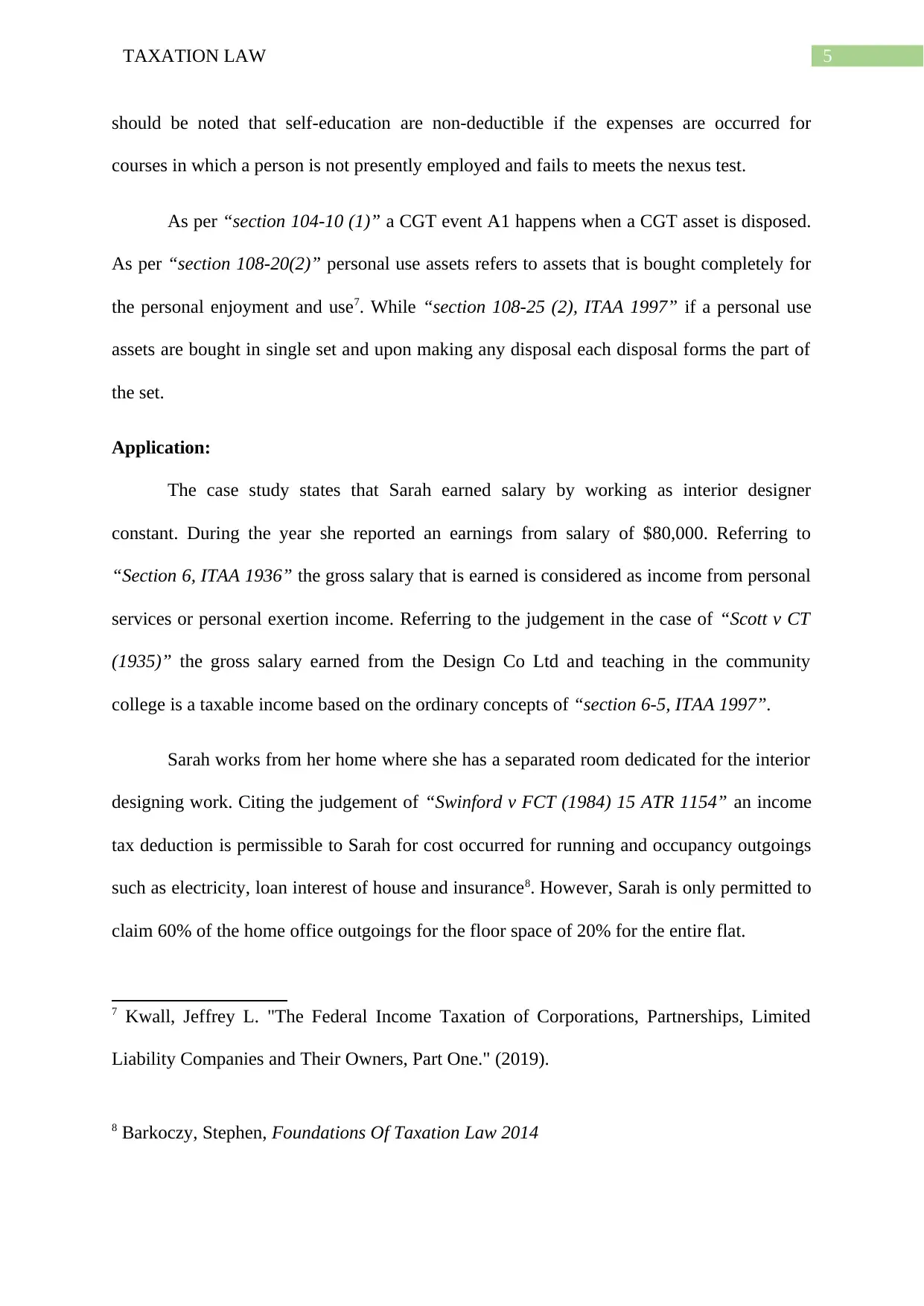
5TAXATION LAW
should be noted that self-education are non-deductible if the expenses are occurred for
courses in which a person is not presently employed and fails to meets the nexus test.
As per “section 104-10 (1)” a CGT event A1 happens when a CGT asset is disposed.
As per “section 108-20(2)” personal use assets refers to assets that is bought completely for
the personal enjoyment and use7. While “section 108-25 (2), ITAA 1997” if a personal use
assets are bought in single set and upon making any disposal each disposal forms the part of
the set.
Application:
The case study states that Sarah earned salary by working as interior designer
constant. During the year she reported an earnings from salary of $80,000. Referring to
“Section 6, ITAA 1936” the gross salary that is earned is considered as income from personal
services or personal exertion income. Referring to the judgement in the case of “Scott v CT
(1935)” the gross salary earned from the Design Co Ltd and teaching in the community
college is a taxable income based on the ordinary concepts of “section 6-5, ITAA 1997”.
Sarah works from her home where she has a separated room dedicated for the interior
designing work. Citing the judgement of “Swinford v FCT (1984) 15 ATR 1154” an income
tax deduction is permissible to Sarah for cost occurred for running and occupancy outgoings
such as electricity, loan interest of house and insurance8. However, Sarah is only permitted to
claim 60% of the home office outgoings for the floor space of 20% for the entire flat.
7 Kwall, Jeffrey L. "The Federal Income Taxation of Corporations, Partnerships, Limited
Liability Companies and Their Owners, Part One." (2019).
8 Barkoczy, Stephen, Foundations Of Taxation Law 2014
should be noted that self-education are non-deductible if the expenses are occurred for
courses in which a person is not presently employed and fails to meets the nexus test.
As per “section 104-10 (1)” a CGT event A1 happens when a CGT asset is disposed.
As per “section 108-20(2)” personal use assets refers to assets that is bought completely for
the personal enjoyment and use7. While “section 108-25 (2), ITAA 1997” if a personal use
assets are bought in single set and upon making any disposal each disposal forms the part of
the set.
Application:
The case study states that Sarah earned salary by working as interior designer
constant. During the year she reported an earnings from salary of $80,000. Referring to
“Section 6, ITAA 1936” the gross salary that is earned is considered as income from personal
services or personal exertion income. Referring to the judgement in the case of “Scott v CT
(1935)” the gross salary earned from the Design Co Ltd and teaching in the community
college is a taxable income based on the ordinary concepts of “section 6-5, ITAA 1997”.
Sarah works from her home where she has a separated room dedicated for the interior
designing work. Citing the judgement of “Swinford v FCT (1984) 15 ATR 1154” an income
tax deduction is permissible to Sarah for cost occurred for running and occupancy outgoings
such as electricity, loan interest of house and insurance8. However, Sarah is only permitted to
claim 60% of the home office outgoings for the floor space of 20% for the entire flat.
7 Kwall, Jeffrey L. "The Federal Income Taxation of Corporations, Partnerships, Limited
Liability Companies and Their Owners, Part One." (2019).
8 Barkoczy, Stephen, Foundations Of Taxation Law 2014
⊘ This is a preview!⊘
Do you want full access?
Subscribe today to unlock all pages.

Trusted by 1+ million students worldwide
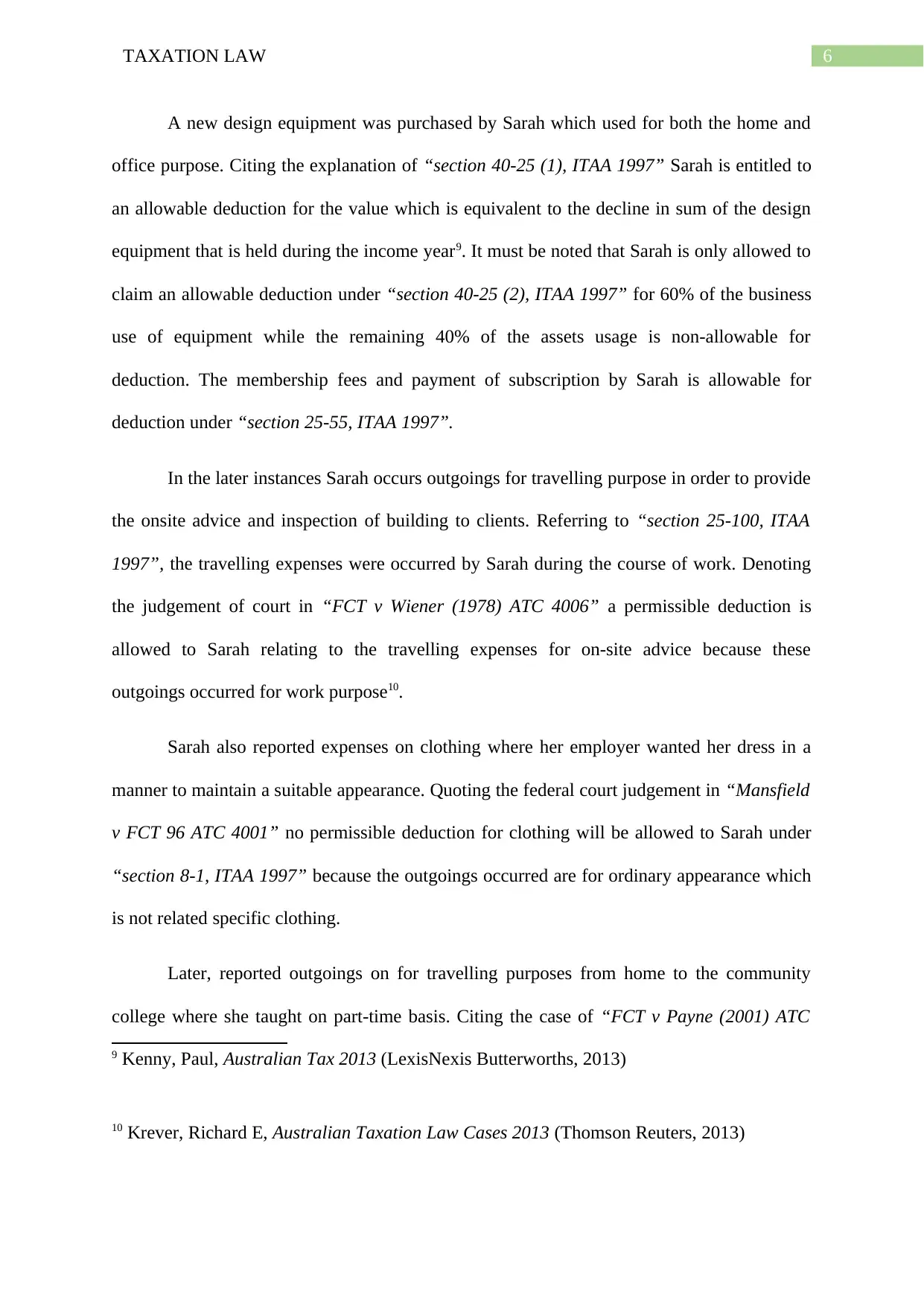
6TAXATION LAW
A new design equipment was purchased by Sarah which used for both the home and
office purpose. Citing the explanation of “section 40-25 (1), ITAA 1997” Sarah is entitled to
an allowable deduction for the value which is equivalent to the decline in sum of the design
equipment that is held during the income year9. It must be noted that Sarah is only allowed to
claim an allowable deduction under “section 40-25 (2), ITAA 1997” for 60% of the business
use of equipment while the remaining 40% of the assets usage is non-allowable for
deduction. The membership fees and payment of subscription by Sarah is allowable for
deduction under “section 25-55, ITAA 1997”.
In the later instances Sarah occurs outgoings for travelling purpose in order to provide
the onsite advice and inspection of building to clients. Referring to “section 25-100, ITAA
1997”, the travelling expenses were occurred by Sarah during the course of work. Denoting
the judgement of court in “FCT v Wiener (1978) ATC 4006” a permissible deduction is
allowed to Sarah relating to the travelling expenses for on-site advice because these
outgoings occurred for work purpose10.
Sarah also reported expenses on clothing where her employer wanted her dress in a
manner to maintain a suitable appearance. Quoting the federal court judgement in “Mansfield
v FCT 96 ATC 4001” no permissible deduction for clothing will be allowed to Sarah under
“section 8-1, ITAA 1997” because the outgoings occurred are for ordinary appearance which
is not related specific clothing.
Later, reported outgoings on for travelling purposes from home to the community
college where she taught on part-time basis. Citing the case of “FCT v Payne (2001) ATC
9 Kenny, Paul, Australian Tax 2013 (LexisNexis Butterworths, 2013)
10 Krever, Richard E, Australian Taxation Law Cases 2013 (Thomson Reuters, 2013)
A new design equipment was purchased by Sarah which used for both the home and
office purpose. Citing the explanation of “section 40-25 (1), ITAA 1997” Sarah is entitled to
an allowable deduction for the value which is equivalent to the decline in sum of the design
equipment that is held during the income year9. It must be noted that Sarah is only allowed to
claim an allowable deduction under “section 40-25 (2), ITAA 1997” for 60% of the business
use of equipment while the remaining 40% of the assets usage is non-allowable for
deduction. The membership fees and payment of subscription by Sarah is allowable for
deduction under “section 25-55, ITAA 1997”.
In the later instances Sarah occurs outgoings for travelling purpose in order to provide
the onsite advice and inspection of building to clients. Referring to “section 25-100, ITAA
1997”, the travelling expenses were occurred by Sarah during the course of work. Denoting
the judgement of court in “FCT v Wiener (1978) ATC 4006” a permissible deduction is
allowed to Sarah relating to the travelling expenses for on-site advice because these
outgoings occurred for work purpose10.
Sarah also reported expenses on clothing where her employer wanted her dress in a
manner to maintain a suitable appearance. Quoting the federal court judgement in “Mansfield
v FCT 96 ATC 4001” no permissible deduction for clothing will be allowed to Sarah under
“section 8-1, ITAA 1997” because the outgoings occurred are for ordinary appearance which
is not related specific clothing.
Later, reported outgoings on for travelling purposes from home to the community
college where she taught on part-time basis. Citing the case of “FCT v Payne (2001) ATC
9 Kenny, Paul, Australian Tax 2013 (LexisNexis Butterworths, 2013)
10 Krever, Richard E, Australian Taxation Law Cases 2013 (Thomson Reuters, 2013)
Paraphrase This Document
Need a fresh take? Get an instant paraphrase of this document with our AI Paraphraser
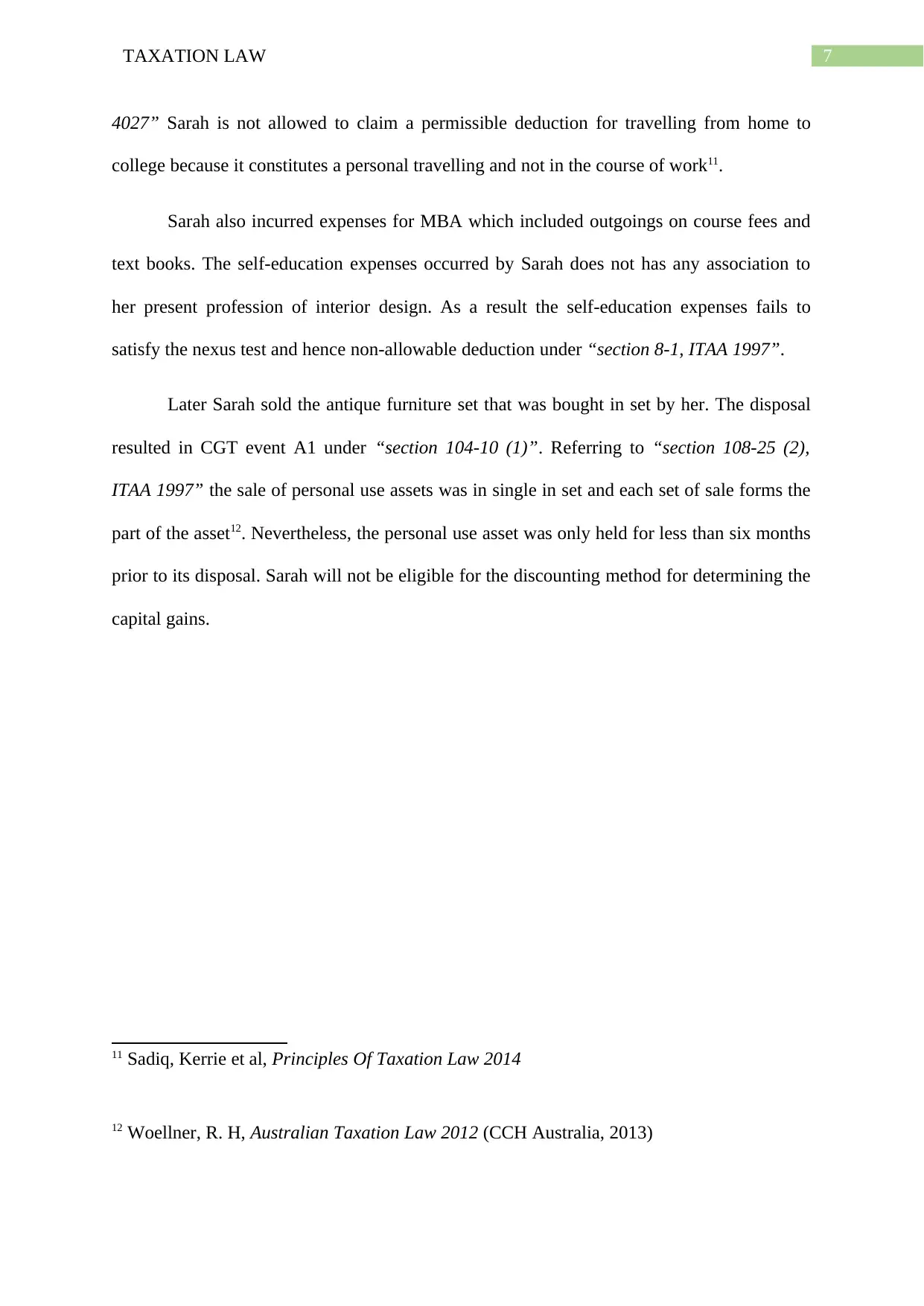
7TAXATION LAW
4027” Sarah is not allowed to claim a permissible deduction for travelling from home to
college because it constitutes a personal travelling and not in the course of work11.
Sarah also incurred expenses for MBA which included outgoings on course fees and
text books. The self-education expenses occurred by Sarah does not has any association to
her present profession of interior design. As a result the self-education expenses fails to
satisfy the nexus test and hence non-allowable deduction under “section 8-1, ITAA 1997”.
Later Sarah sold the antique furniture set that was bought in set by her. The disposal
resulted in CGT event A1 under “section 104-10 (1)”. Referring to “section 108-25 (2),
ITAA 1997” the sale of personal use assets was in single in set and each set of sale forms the
part of the asset12. Nevertheless, the personal use asset was only held for less than six months
prior to its disposal. Sarah will not be eligible for the discounting method for determining the
capital gains.
11 Sadiq, Kerrie et al, Principles Of Taxation Law 2014
12 Woellner, R. H, Australian Taxation Law 2012 (CCH Australia, 2013)
4027” Sarah is not allowed to claim a permissible deduction for travelling from home to
college because it constitutes a personal travelling and not in the course of work11.
Sarah also incurred expenses for MBA which included outgoings on course fees and
text books. The self-education expenses occurred by Sarah does not has any association to
her present profession of interior design. As a result the self-education expenses fails to
satisfy the nexus test and hence non-allowable deduction under “section 8-1, ITAA 1997”.
Later Sarah sold the antique furniture set that was bought in set by her. The disposal
resulted in CGT event A1 under “section 104-10 (1)”. Referring to “section 108-25 (2),
ITAA 1997” the sale of personal use assets was in single in set and each set of sale forms the
part of the asset12. Nevertheless, the personal use asset was only held for less than six months
prior to its disposal. Sarah will not be eligible for the discounting method for determining the
capital gains.
11 Sadiq, Kerrie et al, Principles Of Taxation Law 2014
12 Woellner, R. H, Australian Taxation Law 2012 (CCH Australia, 2013)
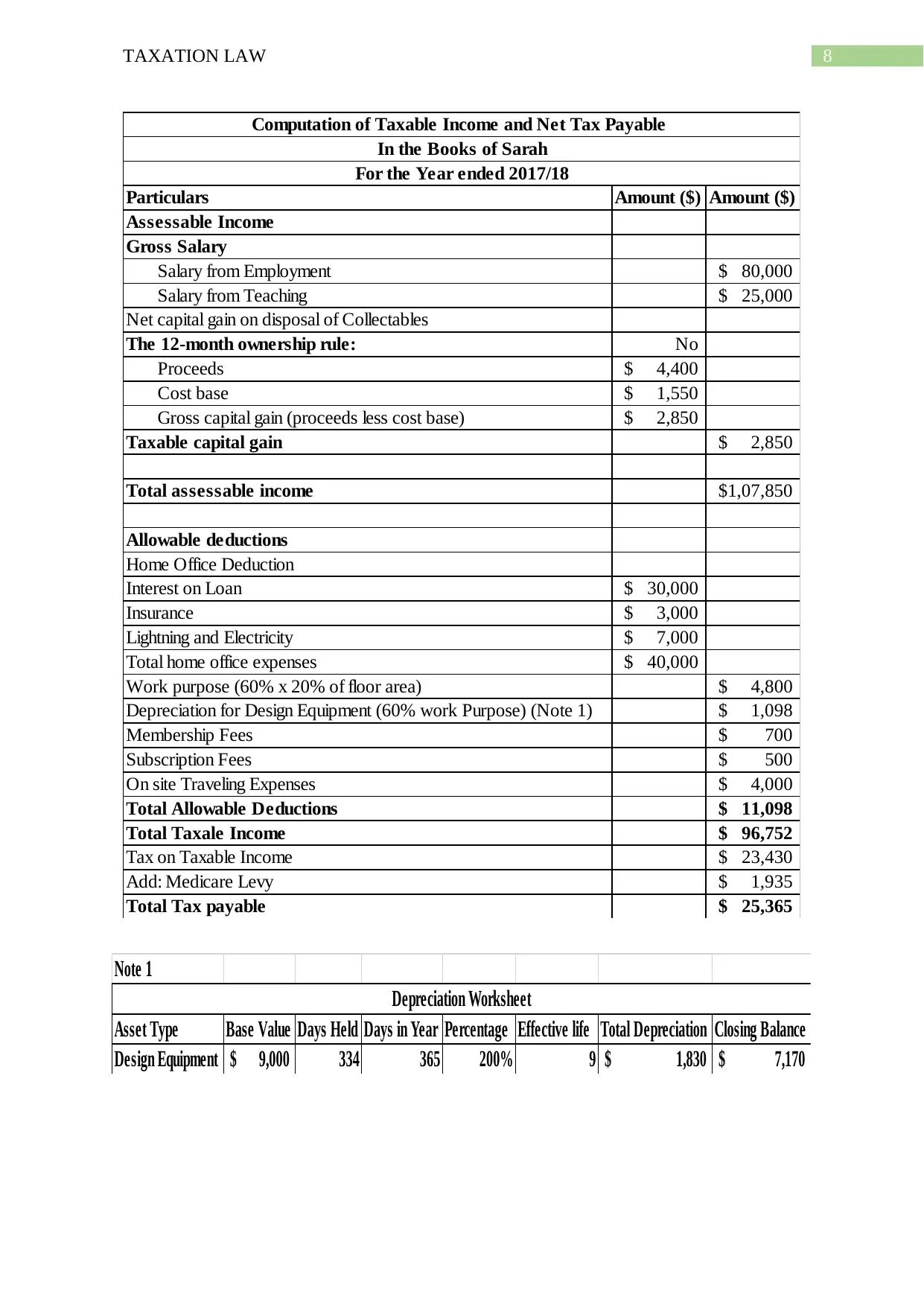
8TAXATION LAW
Particulars Amount ($) Amount ($)
Assessable Income
Gross Salary
Salary from Employment 80,000$
Salary from Teaching 25,000$
Net capital gain on disposal of Collectables
The 12-month ownership rule: No
Proceeds 4,400$
Cost base 1,550$
Gross capital gain (proceeds less cost base) 2,850$
Taxable capital gain 2,850$
Total assessable income 1,07,850$
Allowable deductions
Home Office Deduction
Interest on Loan 30,000$
Insurance 3,000$
Lightning and Electricity 7,000$
Total home office expenses 40,000$
Work purpose (60% x 20% of floor area) 4,800$
Depreciation for Design Equipment (60% work Purpose) (Note 1) 1,098$
Membership Fees 700$
Subscription Fees 500$
On site Traveling Expenses 4,000$
Total Allowable Deductions 11,098$
Total Taxale Income 96,752$
Tax on Taxable Income 23,430$
Add: Medicare Levy 1,935$
Total Tax payable 25,365$
Computation of Taxable Income and Net Tax Payable
In the Books of Sarah
For the Year ended 2017/18
Note 1
Asset Type Base Value Days Held Days in Year Percentage Effective life Total Depreciation Closing Balance
Design Equipment 9,000$ 334 365 200% 9 1,830$ 7,170$
Depreciation Worksheet
Particulars Amount ($) Amount ($)
Assessable Income
Gross Salary
Salary from Employment 80,000$
Salary from Teaching 25,000$
Net capital gain on disposal of Collectables
The 12-month ownership rule: No
Proceeds 4,400$
Cost base 1,550$
Gross capital gain (proceeds less cost base) 2,850$
Taxable capital gain 2,850$
Total assessable income 1,07,850$
Allowable deductions
Home Office Deduction
Interest on Loan 30,000$
Insurance 3,000$
Lightning and Electricity 7,000$
Total home office expenses 40,000$
Work purpose (60% x 20% of floor area) 4,800$
Depreciation for Design Equipment (60% work Purpose) (Note 1) 1,098$
Membership Fees 700$
Subscription Fees 500$
On site Traveling Expenses 4,000$
Total Allowable Deductions 11,098$
Total Taxale Income 96,752$
Tax on Taxable Income 23,430$
Add: Medicare Levy 1,935$
Total Tax payable 25,365$
Computation of Taxable Income and Net Tax Payable
In the Books of Sarah
For the Year ended 2017/18
Note 1
Asset Type Base Value Days Held Days in Year Percentage Effective life Total Depreciation Closing Balance
Design Equipment 9,000$ 334 365 200% 9 1,830$ 7,170$
Depreciation Worksheet
⊘ This is a preview!⊘
Do you want full access?
Subscribe today to unlock all pages.

Trusted by 1+ million students worldwide
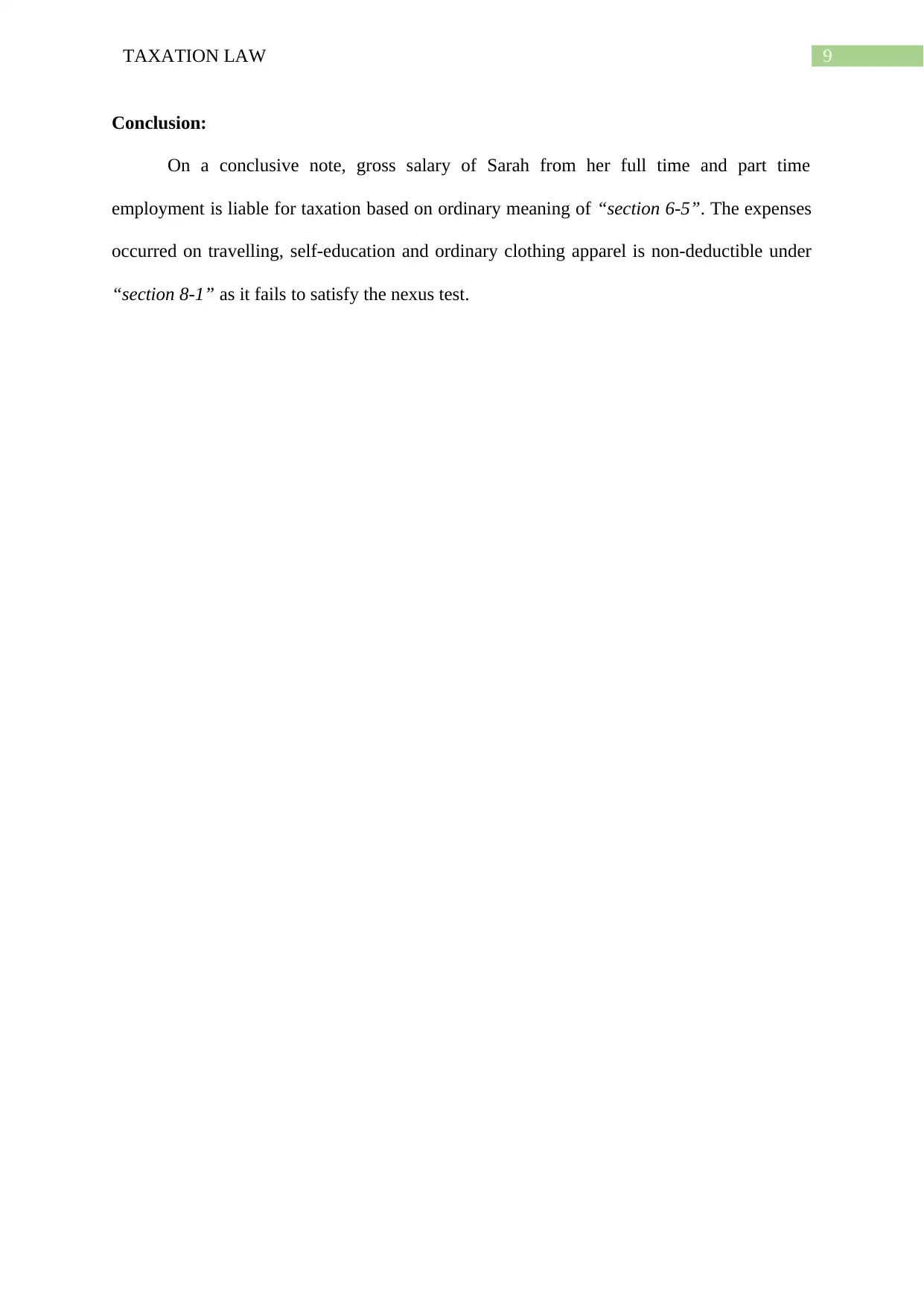
9TAXATION LAW
Conclusion:
On a conclusive note, gross salary of Sarah from her full time and part time
employment is liable for taxation based on ordinary meaning of “section 6-5”. The expenses
occurred on travelling, self-education and ordinary clothing apparel is non-deductible under
“section 8-1” as it fails to satisfy the nexus test.
Conclusion:
On a conclusive note, gross salary of Sarah from her full time and part time
employment is liable for taxation based on ordinary meaning of “section 6-5”. The expenses
occurred on travelling, self-education and ordinary clothing apparel is non-deductible under
“section 8-1” as it fails to satisfy the nexus test.
Paraphrase This Document
Need a fresh take? Get an instant paraphrase of this document with our AI Paraphraser
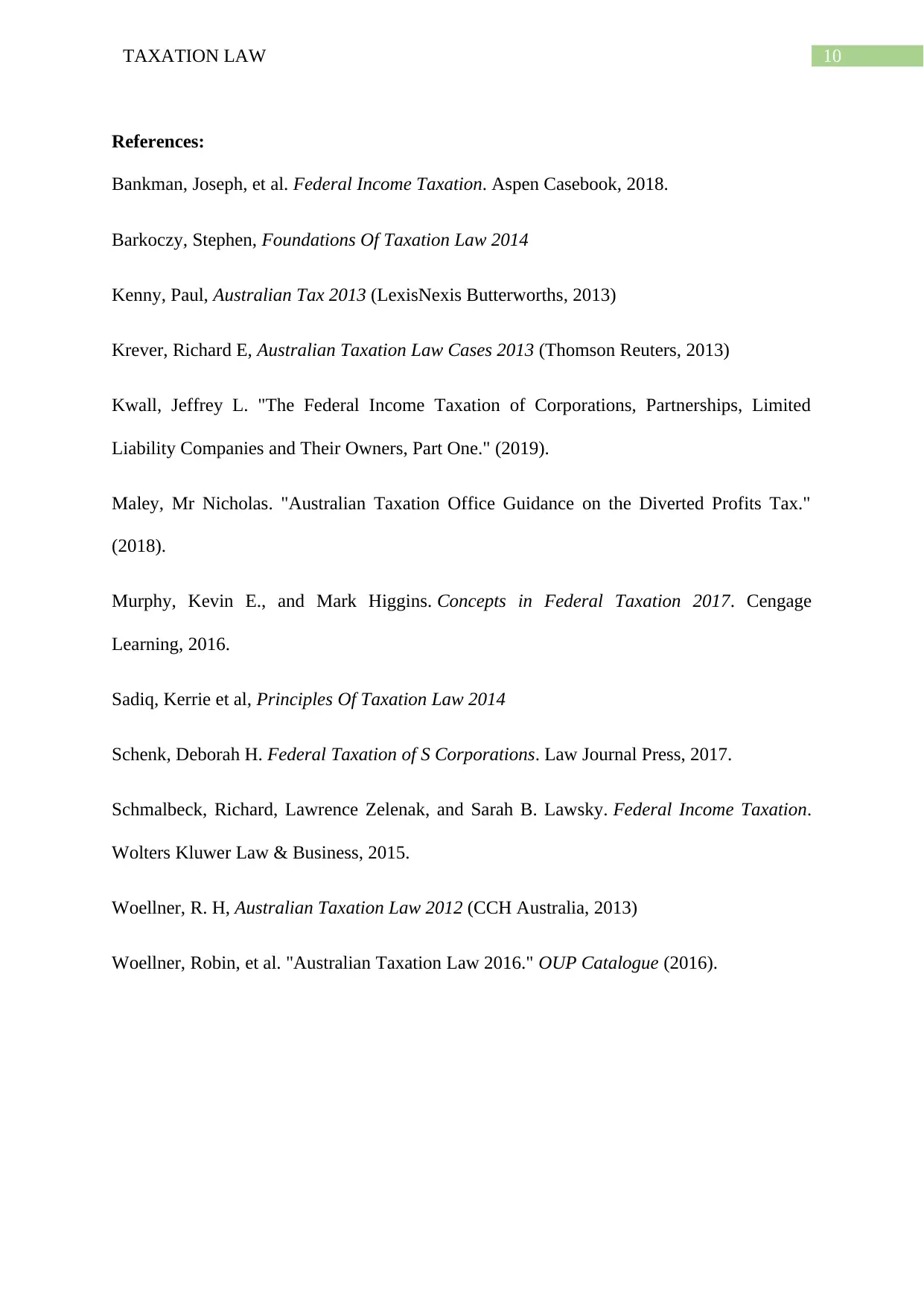
10TAXATION LAW
References:
Bankman, Joseph, et al. Federal Income Taxation. Aspen Casebook, 2018.
Barkoczy, Stephen, Foundations Of Taxation Law 2014
Kenny, Paul, Australian Tax 2013 (LexisNexis Butterworths, 2013)
Krever, Richard E, Australian Taxation Law Cases 2013 (Thomson Reuters, 2013)
Kwall, Jeffrey L. "The Federal Income Taxation of Corporations, Partnerships, Limited
Liability Companies and Their Owners, Part One." (2019).
Maley, Mr Nicholas. "Australian Taxation Office Guidance on the Diverted Profits Tax."
(2018).
Murphy, Kevin E., and Mark Higgins. Concepts in Federal Taxation 2017. Cengage
Learning, 2016.
Sadiq, Kerrie et al, Principles Of Taxation Law 2014
Schenk, Deborah H. Federal Taxation of S Corporations. Law Journal Press, 2017.
Schmalbeck, Richard, Lawrence Zelenak, and Sarah B. Lawsky. Federal Income Taxation.
Wolters Kluwer Law & Business, 2015.
Woellner, R. H, Australian Taxation Law 2012 (CCH Australia, 2013)
Woellner, Robin, et al. "Australian Taxation Law 2016." OUP Catalogue (2016).
References:
Bankman, Joseph, et al. Federal Income Taxation. Aspen Casebook, 2018.
Barkoczy, Stephen, Foundations Of Taxation Law 2014
Kenny, Paul, Australian Tax 2013 (LexisNexis Butterworths, 2013)
Krever, Richard E, Australian Taxation Law Cases 2013 (Thomson Reuters, 2013)
Kwall, Jeffrey L. "The Federal Income Taxation of Corporations, Partnerships, Limited
Liability Companies and Their Owners, Part One." (2019).
Maley, Mr Nicholas. "Australian Taxation Office Guidance on the Diverted Profits Tax."
(2018).
Murphy, Kevin E., and Mark Higgins. Concepts in Federal Taxation 2017. Cengage
Learning, 2016.
Sadiq, Kerrie et al, Principles Of Taxation Law 2014
Schenk, Deborah H. Federal Taxation of S Corporations. Law Journal Press, 2017.
Schmalbeck, Richard, Lawrence Zelenak, and Sarah B. Lawsky. Federal Income Taxation.
Wolters Kluwer Law & Business, 2015.
Woellner, R. H, Australian Taxation Law 2012 (CCH Australia, 2013)
Woellner, Robin, et al. "Australian Taxation Law 2016." OUP Catalogue (2016).
1 out of 11
Related Documents
Your All-in-One AI-Powered Toolkit for Academic Success.
+13062052269
info@desklib.com
Available 24*7 on WhatsApp / Email
![[object Object]](/_next/static/media/star-bottom.7253800d.svg)
Unlock your academic potential
Copyright © 2020–2025 A2Z Services. All Rights Reserved. Developed and managed by ZUCOL.





